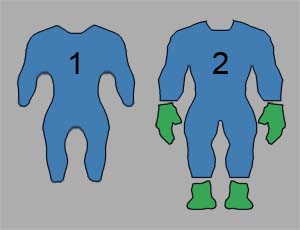-
i modeled a very basic character in maya (#1 see lame attachment below). since it was a test i didn’t bother modeling full hands, feet or a reasonable head. i brought the simple model into zbrush and sculpted it into a model which i liked enough that i want to take it past a test (blue part of #2). problem is i didn’t give myself enough material to sculpt the fingers, toes and parts of the face. so i created separate low-poly geometry for the missing parts, then i imported these separately into zbrush and sculpted then to the same level of detail as the body (green parts of #2). now my problem is matching up these parts with the body (#2). i’d prefere to do this in zbrush but can’t figure out how, as there seems to be no way to add geometry to a previously imported model and retain subdivision hierarchy. my guess is that markers or layers are the way to go but i can’t figure out how to get this to work. is there a way to import the extra parts into ZBrush and sculpt the hands and feet while having the body visible as a reference so i can match up the where the body and parts meet (i.e. ankles, wrists and neck)?
- is there a way to set the default brush size for edit mode. i’ve been able to set the default brush size in Draw Mode creating a a custom defaultzscript.TXT which includes
[ISet,Draw: Draw Size, 40]
[ISet,Draw: Focal Shift,-60]
[ISet,Draw: Z Intensity,5]
however as soon as switch to edit mode the brush size, focal shift, etc… get reset to the pixologic defaults of (64,0,100,…).
Attachments
